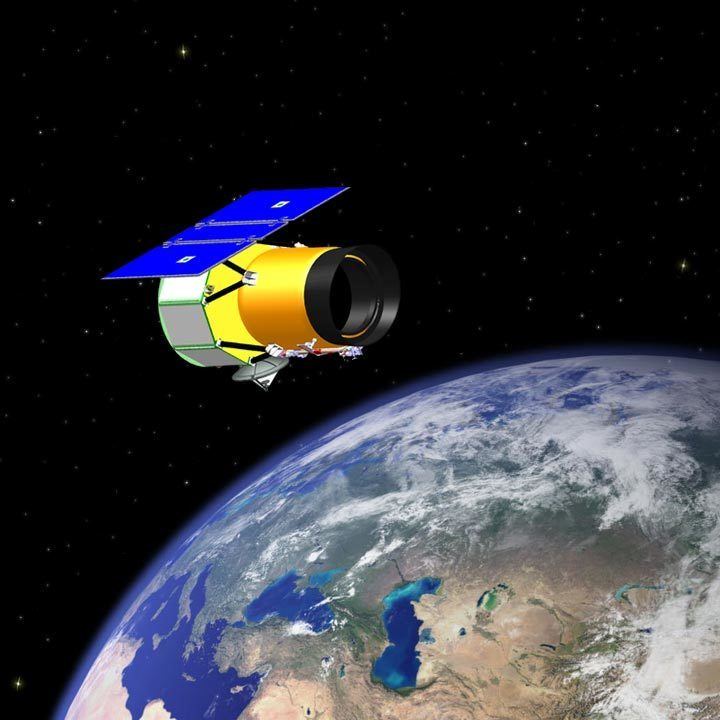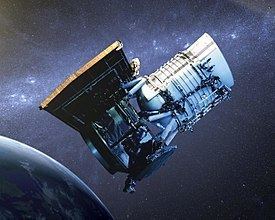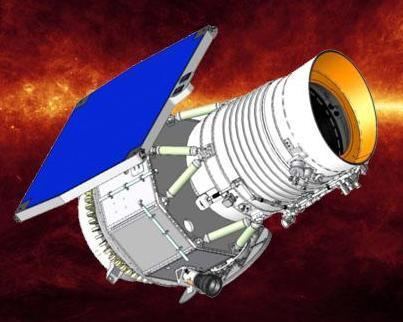COSPAR ID 2009-071A Orbit height 525 km | SATCAT no. 36119 Speed on orbit 7.601 km/s Cost 320 million USD | |
 | ||
Names MIDEX/WISE, Explorer 92 Launch date December 14, 2009, 2:09 PM Similar Spitzer Space Telescope, IRAS, GALEX, James Webb Space Te, Herschel Space Observatory | ||
Nasa s wide field infrared survey explorer wise
Wide-field Infrared Survey Explorer (WISE) is a NASA infrared-wavelength astronomical space telescope launched in December 2009, and placed in hibernation in February 2011 when its transmitter turned off. It was re-activated in 2013. WISE discovered thousands of minor planets and numerous star clusters. Its observations also supported the discovery of the first Y Dwarf and Earth trojan asteroid.
Contents
- Nasa s wide field infrared survey explorer wise
- First images from wise the wide field infrared survey explorer
- Mission goals
- Targets outside the Solar System
- Targets within the Solar System
- Spacecraft
- Mission
- Congressional hearing
- Results
- Project milestones
- Launch
- Cold mission
- NEOWISE pre hibernation
- Hibernation and recommissioning
- NEOWISE post hibernation
- Data releases
- Brown dwarfs
- Minor planets
- References

WISE performed an all-sky astronomical survey with images in 3.4, 4.6, 12 and 22 μm wavelength range bands, over ten months using a 40 cm (16 in) diameter infrared telescope in Earth orbit. After its hydrogen coolant depleted, a four-month mission extension called NEOWISE was conducted to search for near-Earth objects such as comets and asteroids using its remaining capability.

The All-Sky data including processed images, source catalogs and raw data, was released to the public on March 14, 2012, and is available at the Infrared Science Archive. In August 2013, NASA announced it would reactivate the WISE telescope for a new three-year mission to search for asteroids that could collide with Earth. Science operations and data processing for WISE and NEOWISE take place at the Infrared Processing and Analysis Center at the California Institute of Technology in Pasadena.

In May 2016, significant asteroid data arising from the Wide-field Infrared Survey Explorer and NEOWISE missions have been questioned, but the criticism has yet to undergo peer review.

First images from wise the wide field infrared survey explorer
Mission goals

The mission was planned to create infrared images of 99 percent of the sky, with at least eight images made of each position on the sky in order to increase accuracy. The spacecraft was placed in a 525 km (326 mi), circular, polar, Sun-synchronous orbit for its ten-month mission, during which it has taken 1.5 million images, one every 11 seconds. The satellite orbited above the terminator, its telescope pointing always to the opposite direction to the Earth, except for pointing towards the Moon, which was avoided, and its solar cells towards the Sun. Each image covers a 47-arcminute field of view, which means a 6-arcsecond resolution. Each area of the sky was scanned at least 10 times at the equator; the poles were scanned at theoretically every revolution due to the overlapping of the images. The produced image library contains data on the local Solar System, the Milky Way, and the more distant universe. Among the objects WISE studied are asteroids, cool, dim stars such as brown dwarfs, and the most luminous infrared galaxies.
Targets outside the Solar System
Stellar nurseries, which are covered by interstellar dust, are detectable in infrared, since at this wavelength electromagnetic radiation can penetrate the dust. Infrared measurements from the WISE astronomical survey have been particularly effective at unveiling previously undiscovered star clusters. Examples of such embedded star clusters are Camargo 18, Camargo 440, Majaess 101, and Majaess 116. In addition, galaxies of the young Universe and interacting galaxies, where star formation is intensive, are bright in infrared. On this wavelength the interstellar gas clouds are also detectable, as well as proto-planetary discs. WISE satellite was expected to find at least 1,000 of those proto-planetary discs.
Targets within the Solar System
WISE was not able to detect Kuiper belt objects, because their temperatures are too low. It was able to detect any objects warmer than 70–100 K. A Neptune-sized object would be detectable out to 700 AU, a Jupiter-mass object out to 1 light year (63,000 AU), where it would still be within the Sun's zone of gravitational control. A larger object of 2–3 Jupiter masses would be visible at a distance of up to 7–10 light years.
At the time of planning, it was estimated that WISE would detect about 300,000 main-belt asteroids, of which approximately 100,000 will be new, and some 700 near-Earth objects (NEO) including about 300 undiscovered. That translates to about 1000 new main-belt asteroids per day, and 1–3 NEOs per day. The peak of magnitude distribution for NEOs will be about 21–22 V. WISE would detect each typical Solar System object 10–12 times over about 36 hours in intervals of 3 hours.
Spacecraft
Construction of the WISE telescope was divided between Ball Aerospace & Technologies (spacecraft, operations support), SSG Precision Optronics, Inc. (telescope, optics, scan mirror), DRS and Rockwell (focal planes), Lockheed Martin (cryostat, cooling for the telescope), and Space Dynamics Laboratory (instruments, electronics, and testing). The program was managed through the Jet Propulsion Laboratory.
The WISE instrument was built by the Space Dynamics Laboratory in Logan, Utah. The WISE spacecraft bus was built by Ball Aerospace and Technologies Corp. in Boulder, Colorado. The spacecraft is derived from the Ball Aerospace RS-300 spacecraft architecture, particularly the NEXTSat spacecraft built for the successful Orbital Express mission launched on March 9, 2007. The flight system has an estimated mass of 560 kg (1,230 lb). The spacecraft is three-axis stabilized, with body-fixed solar arrays. It uses a high-gain antenna in the Ku band to transmit to the ground through the TDRSS geostationary system. Ball also performed the testing and flight system integration.
Mission
WISE surveyed the sky in four wavelengths of the infrared band, at a very high sensitivity. Its design specified as goals that the full sky atlas of stacked images it produced have 5-sigma sensitivity limits of 120, 160, 650, and 2600 microjanskies (µJy) at 3.3, 4.7, 12, and 23 micrometers (aka microns). WISE achieved at least 68, 98, 860, and 5400 µJy 5-sigma sensitivity at 3.4, 4.6, 12, and 22 micrometers for the WISE All-Sky data release. This is a factor of 1,000 times better sensitivity than the survey completed in 1983 by the IRAS satellite in the 12 and 23 micrometers (micron) bands, and a factor of 500,000 times better than the 1990s survey by the Cosmic Background Explorer (COBE) satellite at 3.3 and 4.7 micrometers. On the other hand, IRAS could also observe 60 and 100 micron wavelengths.
The primary mission lasted ten months: one month for checkout, six months for a full-sky survey, then an additional three months of survey until cryogenic coolant (which kept the instruments at 17 K) ran out. The partial second survey pass facilitated the study of changes (e.g. orbital movement) in observed objects.
Congressional hearing
On November 8, 2007, the House Committee on Science and Technology's Subcommittee on Space and Aeronautics held a hearing to examine the status of NASA's Near-Earth Object (NEO) survey program. The prospect of using WISE was proposed by NASA officials.
NASA officials told Committee staff that NASA plans to use WISE to detect near-Earth objects in addition to performing its science goals. It was projected that WISE could detect 400 NEOs (or roughly 2 percent of the estimated NEO population of interest) within its one-year mission.
Results
By October 2010, over 33,500 new asteroids and comets were discovered, and nearly 154,000 Solar System objects were observed by WISE.
Discovery of an ultra-cool brown dwarf, WISEPC J045853.90+643451.9, about 10 to 30 light years away from Earth, was announced in late 2010 based on early data. In July 2011 it was announced that WISE had discovered the first Earth trojan asteroid, 2010 TK7. Also, the third-closest star system, Luhman 16.
As of November 2016, WISE/NEOWISE has also discovered 249 near-Earth objects and comets (see section below).
Project milestones
The WISE Mission is led by Dr. Edward L. Wright of the University of California, Los Angeles. The mission has a long history under Wright's efforts, and was first funded by NASA in 1999 as a candidate for a NASA Medium-class Explorer (MIDEX) mission under the name Next Generation Sky Survey (NGSS). The history of the program from 1999 to date is briefly summarized as follows:
Launch
The launch of the Delta II rocket carrying the WISE spacecraft was originally scheduled for December 11, 2009. This attempt was scrubbed to correct a problem with a booster rocket steering engine. The launch was then rescheduled for December 14, 2009. The second attempt launched on time at 14:09:33 UTC (06:09 local PST) from Vandenberg Air Force Base in California. The rocket successfully placed the WISE spacecraft into the planned polar orbit at an altitude of 326 miles (525 km) above the Earth.
WISE avoided the problem that affected Wide Field Infrared Explorer (WIRE), which failed within hours of reaching orbit in March 1999. In addition, WISE was 1,000 times more sensitive than prior surveys such as IRAS, AKARI, and COBE's DIRBE.
"Cold" mission
A month-long checkout after launch found all spacecraft systems functioning normally and both the low- and high-rate data links to the operations center working properly. The instrument cover was successfully jettisoned on December 29, 2009. A first light image was released on January 6, 2010: an eight-second exposure in the Carina constellation showing infrared light in false color from three of WISE's four wavelength bands: Blue, green and red corresponding to 3.4, 4.6, and 12 micrometers, respectively. On January 14, 2010, the WISE mission started its official sky survey. The WISE group's bid for continued funding for an extended "warm mission" scored low by a NASA review board, in part because of a lack of outside groups publishing on WISE Data. Such a mission would have allowed use of the 3.4 and 4.6 micrometers detectors after the last of cryo-coolant had been exhausted, with the goal of completing a second sky survey to detect additional objects and obtain parallax data on putative brown dwarf stars. NASA extended the mission in October 2010 to search for near-Earth objects.
By October 2010, over 33,500 new asteroids and comets were discovered, and over 154,000 Solar System objects were observed by WISE. While active it found dozens of previously unknown asteroids every day. In total, it captured more than 2.7 million images during its primary mission.
NEOWISE (pre-hibernation)
In October 2010, NASA extended the mission by one month with a program called Near-Earth Object WISE (NEOWISE). Due to its success, the program was extended a further three months. The focus was to look for asteroids and comets close to Earth orbit, using the remaining post-cryogenic detection capability (two of four detectors on WISE work without cryogen). In February 2011, NASA announced that NEOWISE had discovered many new objects in the Solar System, including twenty comets. During its primary and extended missions, the spacecraft delivered characterizations of 158,000 minor planets, including more than 35,000 newly discovered objects.
Hibernation and recommissioning
After completing a full scan of the asteroid belt for the NEOWISE mission, the spacecraft was put into hibernation on February 1, 2011. The spacecraft was briefly contacted to check its status on September 20, 2012.
On August 21, 2013, NASA announced it would recommission WISE to continue its search for near-Earth objects and potentially dangerous asteroids. It would additionally search for asteroids that a robotic spacecraft could intercept and redirect to orbit the Moon. The extended mission would be for three years at a cost of $5 million per year, and was brought about in part due to calls for NASA to step up asteroid detection after the Chelyabinsk meteor exploded over Russia in February 2013.
WISE was successfully taken out of hibernation in September 2013. With its coolant depleted, the spacecraft's temperature was reduced from 200 K (−73 °C; −100 °F)—a relatively high temperature resulting from its hibernation—to an operating temperature of 75 K (−198.2 °C; −324.7 °F) by having the telescope stare into deep space. Its instruments were then re-calibrated, and the first post-hibernation photograph was taken on December 19, 2013.
NEOWISE (post-hibernation)
The post-hibernation NEOWISE mission was anticipated to discover 150 previously unknown near-Earth objects and to learn more about the characteristics of 2,000 known asteroids. Few objects smaller than 100 m (330 ft) in diameter were detected by NEOWISE's automated detection software, known as the WISE Moving Object Processing Software (WMOPS), because it requires five or more detections to be reported. The average albedo of asteroids larger than 100 meters discovered by NEOWISE is 0.14.
As of November 2016, WISE/NEOWISE statistics lists a total of 249 near-Earth objects (NEOs), including 2016 WF9 and C/2016 U1, discovered by the spacecraft:
Of the 222 near-Earth asteroids (NEAs), 43 of them are considered potentially hazardous asteroids (PHAs), a subset of the much larger family of NEOs, but particularly more likely to hit Earth and cause significant destruction. NEOs can be divided into NECs (comets only) and NEAs (asteroids only), and further into subcategories such as Atira or Apohele asteroids, Aten asteroids, Apollo asteroids, Amor asteroids and the potentially hazardous asteroids (PHAs).
Data releases
On April 14, 2011, a preliminary release of WISE data was made public, covering 57 percent of the sky observed by the spacecraft. On March 14, 2012, a new atlas and catalog of the entire infrared sky as imaged by WISE was released to the astronomic community. On July 31, 2012 NEOWISE Post-Cryo Preliminary Data was released. A release called AllWISE, combining all data, was approved.
Brown dwarfs
The nearest brown dwarfs discovered by WISE within 20 light-years include:
Before the discovery of Luhman 16 in 2013, WISE 1506+7027 at a distance of 11.1+2.3
−1.3 light-years was suspected to be closest brown dwarf on the list of nearest stars (also see § Map with nearby WISE stars).
Minor planets
WISE is credited with discovering 3,088 numbered minor planets. Examples of the mission's numbered minor planet discoveries include:
